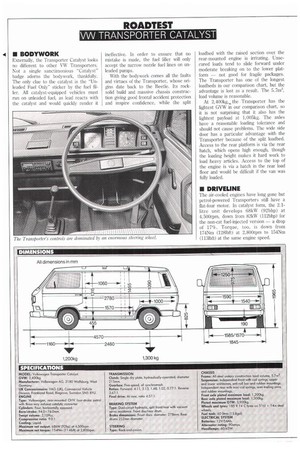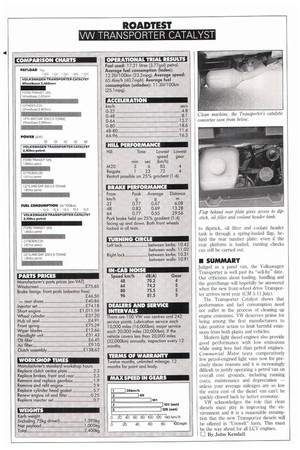ROADTEST VW TRANSPORTER CATALYST
Page 56

Page 57

Page 58

If you've noticed an error in this article please click here to report it so we can fix it.
Externally, the Transporter Catalyst looks no different to other VW Transporters. Not a single sanctimonious "Catalyst" badge adorns the bodywork, thankfully. The only clue to the catalyst is the "Unleaded Fuel Only" sticker by the fuel filler. All catalyst-equipped vehicles must run on unleaded fuel, as lead reacts with the catalyst and would quickly render it ineffective. In order to ensure that no mistake is made, the fuel filler will only accept the narrow nozzle fuel lines on unleaded pumps.
With the bodywork comes all the faults and virtues of the Transporter, whose origins date back to the Beetle. Its rocksolid build and massive chassis construction giving good frontal accident protection and inspire confidence, while the split
loadbed with the raised section over the rear-mounted engine is irritating. Unsecured loads tend to slide forward under moderate breaking on to the lower platform — not good for fragile packages. The Transporter has one of the longest loadbeds in our comparison chart, but the advantage is lost as a result. The 5.7m3, load volume is reasonable.
At 2,400kg,.the Transporter has the lightest GVW in our comparison chart, Sc) it is not surprising that it also has the lightest payload at 1,005kg. The axles have a reasonable loading tolerance and should not cause problems. The wide side door has a particular advantage with the Transporter because of the split loadbed. Access to the rear platform is via the rear hatch, which opens high enough, though the loading height makes it hard work to load heavy articles. Access to the top of the engine is via a hatch in the rear load floor and would be difficult if the van was fully loaded.
The air-cooled engines have long gone but petrol-powered Transporters still have a flat-four motor. In catalyst form, the 2.1litre unit develops 68kW (92bhp) at 4,500rpm, down from 82kW (112bhp) for the non-cat fuel-injected version — a drop of 17%. Torque, too, is down from 174Nm (1281bft) at 2,800rpm to 154Nm (11:3lbft) at the same engine speed.
Fuel injection is obligatory with a threeway catalytic converter, as the mixture must be constantly adjusted to ensure the exhaust gases are as "clean" as possible. "Three-way" refers to the three types of pollutant that are treated by the catalyst. Hydrocarbons, carbon monoxide and nitrous oxides are converted into carbon dioxide, nitrogen and water. Although the resultant gases are harmless, carbon dioxide is a known contributor to the "greenhouse effect''. Catalytic action is also temperature-dependent and on short journeys, when the system has not reached working temperature, its effectiveness is considerably reduced.
Drive is transmitted to the rear wheels through a transaxle, incorporating the five-speed gearbox and final drive. Ratios for the gearbox are all indirect with fifth providing an overdrive ratio.
Any suggestion that the reduced power of the catalyst version turns the Transporter into an unbearable slouch is not borne out by our results. Its performance betters most of the rivals in our comparison charts. Against this, it carries a lighter load than most, although with greater power, even with the catalyst.
The flat-four engine fires up willingly and is remarkably smooth, even at tickover. Gearing is well matched to the engine and the Transporter managed the M20 and A20 hill climbs with ease.
Set against this, the gearchange is abominable. This is due in part to the rearmounted gearbox and the long linkages between lever and box that result. The gate is wide and the lever has a long throw, which means that engaging reverse invariably involves changing stations on the radio. The dog leg first to second change is best taken slowly, while changing from fourth to third was always thoroughly frustrating. Regardless of how carefully the lever was moved, selecting third was somewhere between impossible and easy. Mostly, this was because the third gear "slot" was not always in the same place, suggesting excessive play in the linkages.
The information supplied with the Transporter shows fuel consumption to be inferior to the non-cat equipped fuel injection model, which is what we would expect. Despite this, the Transporter catalyst still returned the best fuel consumption figures in our comparison chart. Though no match for the diesel Transporter, our laden consumption of 12.21it/ 100km (23.2mpg) is good for a petroldriven panel van. This is over 6% better than its closest rival in our comparison chart, the Transit 120L, which recorded 13.071k/100km (21. 62mpg), also on unleaded fuel.
The lighter weight of the Transporter will have helped it again here, although its aerodynamics are not in the same league as some more recent designs.
The Transporter again shows its Beetle origins in its road behaviour. Although the swing-axle rear suspension was banished in favour of semi-trailing arms, there is still a tendency towards lift-off oversteer if pushed hard. The engine position outboard of the rear axle also does not-help.
We have commented on the straightline stability of Transporters before — and the Catalyst is no different. There is a tendency to wander at speed, particularly when the vehicle is unladen. At town speeds, the problem does not arise and although the steering is not particularly • light, the enormous steering wheel makes manoeuvring relatively easy.
The Transporter is one of the few panel vans with all-round coil springing and the ride is firm but comfortable, even when running empty. Braking performance was good, rather than exceptional, lacking the quick response of some rivals like the Mitsubishi 1.300. In our emergency stop testing, the front wheels locked each time, but the VW always pulled up in a straight line.
The dashboard finish is characteristically VW — all black, but the space inside the cab and the finish of the seat cloth facings prevent it from being oppressive. The feeling of space is noticeable compared with some Japanese rivals, mainly as the Transporter is wider and there is no engine between the front seats.
Stowage is reasonable, with a large lockable drop-down compartment in front of the passenger seat, a door bin on the driver's side and a tool-box behind the passenger seat. Instrumentation is lifted from the VW Golf with a large clearly marked speedometer and clock with inset temperature and fuel gauges. Warning Lights supplement the gauges. Column stalks control headlamp dip/ flash and indicators on the left and wash/ wipe on the right. The wipers have two speeds, plus intermittent wipe. Unfortunately, no wiper is fitted to the rear tailgate, as on Japanese rivals, so the rear wipe soon gets covered in road dirt.
The heating and ventilation system provides good throughput but the fascia vents are heater-dependent. 'Fhe layout of the three horizontal slides is confused too. The top and bottom slides control volume to the windscreen and floor, respectively, while the middle controls heat. The twovolume slides work in opposite directions for some reason which means they cannot be operated easily by touch alone.
Although the engine is remarkably smooth and vibration-free, this is spoiled by the loud roar it makes. When loaded, the noise is masked slightly but we still recorded 81.5 dB(A) at 96 km/h in fifth gear. With 10,000-mile (1,610km) service intervals, the Transporter should not be a costly vehicle to keep on the road. Access to dipstick, oil filter and coolant header tank is through a spring-loaded flap, behind the rear number plate: even if the rear platform is loaded, running checks can still be carried out.
Judged as a panel van, the Volkswagen Transporter is well past its "sell-by" date. Our criticisms about loading, handling and the gearchange will hopefully be answered when the new front-wheel drive Transporter arrives next year (CM 5-11 July).
The Transporter Catalyst shows that performance and fuel consumption need not suffer in the process of cleaning up engine emissions. VW deserves praise for being among the first manufacturers to take positive action to limit harmful emissions from both plants and vehicles.
Modern light diesel engines also provide good performance with low emissions while using less fuel than petrol engines. Commercial Motor tests comparatively few petrol-engined light vans now for precisely those reasons and it is increasingly difficult to justify operating a petrol van on overall cost grounds, including running costs, maintenance and depreciation unless your average mileages are so low the extra cost of the diesel van can't be quickly clawed back by better economy.
VW acknowledges the role that clean diesels must play in improving the environment and it is a reasonable assumption that the new Transporter diesels will be offered in "limwelt" form. This must be the way ahead for all LCV engines.
LI By John Kendall




































































































